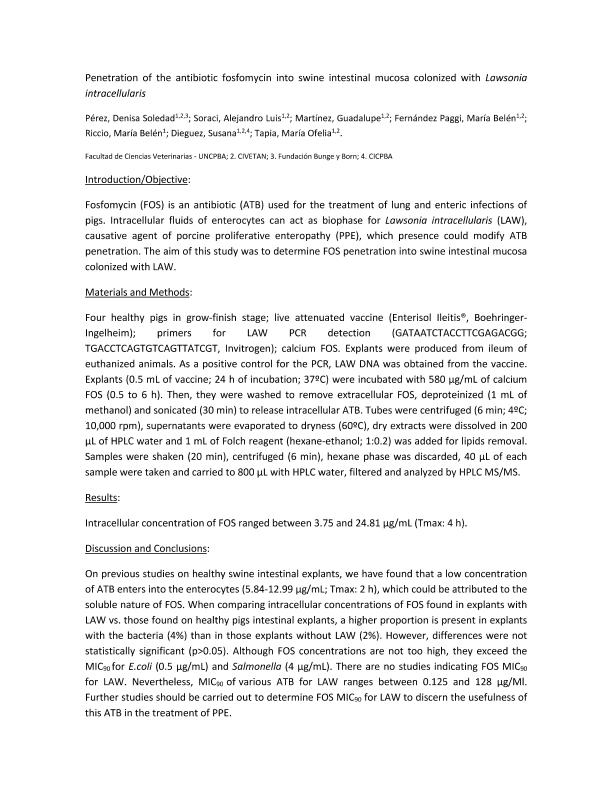Artículo
Ex vivo penetration of fosfomycin into healthy and Lawsonia intracellularis- colonized swine intestinal mucosa
Pérez, Denisa Soledad ; Martínez, Guadalupe
; Martínez, Guadalupe ; Fernández Paggi, María Belén
; Fernández Paggi, María Belén ; Decundo, Julieta María
; Decundo, Julieta María ; Romanelli, Agustina
; Romanelli, Agustina ; Dieguez, Susana Nelly; Soraci, Alejandro Luis
; Dieguez, Susana Nelly; Soraci, Alejandro Luis
 ; Martínez, Guadalupe
; Martínez, Guadalupe ; Fernández Paggi, María Belén
; Fernández Paggi, María Belén ; Decundo, Julieta María
; Decundo, Julieta María ; Romanelli, Agustina
; Romanelli, Agustina ; Dieguez, Susana Nelly; Soraci, Alejandro Luis
; Dieguez, Susana Nelly; Soraci, Alejandro Luis
Fecha de publicación:
07/2018
Editorial:
Wiley Blackwell Publishing, Inc
Revista:
Journal of Veterinary Pharmacology and Therapeutics
ISSN:
0140-7783
Idioma:
Inglés
Tipo de recurso:
Artículo publicado
Clasificación temática:
Resumen
Fosfomycin (FOS) is an antibiotic (ATB) used for the treatment of lung and enteric infections of pigs. Intracellular fluids of enterocytes can act as biophase for Lawsonia intracellularis (LAW), causative agent of porcine proliferative enteropathy (PPE), which presence could modify ATB penetration. The aim of this study was to determine FOS penetration into swine intestinal mucosa colonized with LAW.Four healthy pigs in grow-finish stage; live attenuated vaccine (Enterisol Ileitis®, Boehringer-Ingelheim); primers for LAW PCR detection (GATAATCTACCTTCGAGACGG; TGACCTCAGTGTCAGTTATCGT, Invitrogen); calcium FOS. Explants were produced from ileum of euthanized animals. As a positive control for the PCR, LAW DNA was obtained from the vaccine. Explants (0.5 mL of vaccine; 24 h of incubation; 37ºC) were incubated with 580 µg/mL of calcium FOS (0.5 to 6 h). Then, they were washed to remove extracellular FOS, deproteinized (1 mL of methanol) and sonicated (30 min) to release intracellular ATB. Tubes were centrifuged (6 min; 4ºC; 10,000 rpm), supernatants were evaporated to dryness (60ºC), dry extracts were dissolved in 200 µL of HPLC water and 1 mL of Folch reagent (hexane-ethanol; 1:0.2) was added for lipids removal. Samples were shaken (20 min), centrifuged (6 min), hexane phase was discarded, 40 µL of each sample were taken and carried to 800 µL with HPLC water, filtered and analyzed by HPLC MS/MS. Intracellular concentration of FOS ranged between 3.75 and 24.81 µg/mL (Tmax: 4 h).On previous studies on healthy swine intestinal explants, we have found that a low concentration of ATB enters into the enterocytes (5.84-12.99 μg/mL; Tmax: 2 h), which could be attributed to the soluble nature of FOS. When comparing intracellular concentrations of FOS found in explants with LAW vs. those found on healthy pigs intestinal explants, a higher proportion is present in explants with the bacteria (4%) than in those explants without LAW (2%). However, differences were not statistically significant (p>0.05). Although FOS concentrations are not too high, they exceed the MIC90 for E.coli (0.5 µg/mL) and Salmonella (4 µg/mL). There are no studies indicating FOS MIC90 for LAW. Nevertheless, MIC90 of various ATB for LAW ranges between 0.125 and 128 µg/Ml. Further studies should be carried out to determine FOS MIC90 for LAW to discern the usefulness of this ATB in the treatment of PPE.
Palabras clave:
Fosfomycin
,
Intestinal Mucosa
,
Lawsonia Intracellularis
,
Swine
Archivos asociados
Licencia
Identificadores
Colecciones
Articulos(CIVETAN)
Articulos de CENTRO DE INVESTIGACION VETERINARIA DE TANDIL
Articulos de CENTRO DE INVESTIGACION VETERINARIA DE TANDIL
Citación
Pérez, Denisa Soledad; Martínez, Guadalupe; Fernández Paggi, María Belén; Decundo, Julieta María; Romanelli, Agustina; et al.; Ex vivo penetration of fosfomycin into healthy and Lawsonia intracellularis- colonized swine intestinal mucosa; Wiley Blackwell Publishing, Inc; Journal of Veterinary Pharmacology and Therapeutics; 38; S1; 7-2018; 94-94
Compartir
Altmétricas



